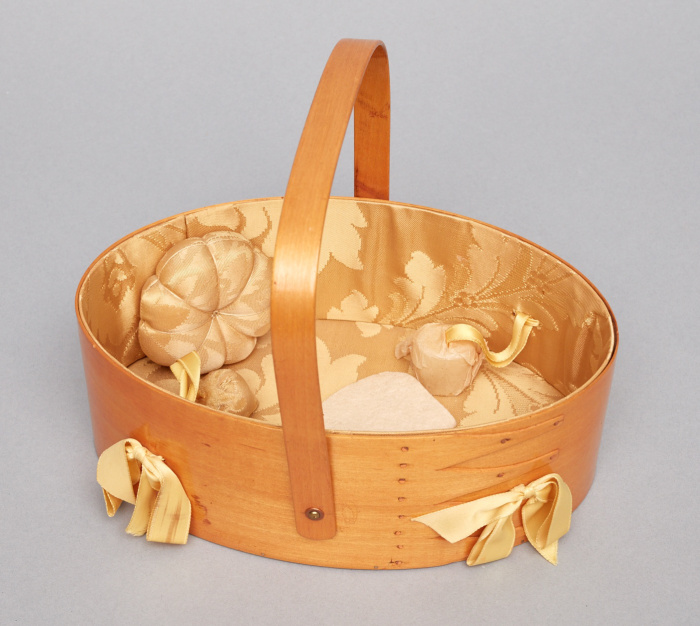
Oval Carrier, Church Family, Sabbathday Lake, ME, ca. 1950, Shaker Museum | Mount Lebanon: 1953.6219.1 John Mulligan, photographer.
Shaker Museum | Mount Lebanon’s founder, John S. Williams, Sr., often collected things that others ignored – Shaker things that others left behind or probably kicked aside. It was perhaps his time on the Board of Trustees for the Museum of the American Indian in New York City where he absorbed a cultural anthropologist’s approach to collecting rather […]

Pattern for the Handle for Large Carriers, Church Family, Sabbathday Lake, ME, ca. 1950s, Shaker Museum | Mount Lebanon: 2017.4.1.
Shaker Museum | Mount Lebanon’s founder, John S. Williams, Sr., often collected things that others ignored – Shaker things that others left behind or probably kicked aside. It was perhaps his time on the Board of Trustees for the Museum of the American Indian in New York City where he absorbed a cultural anthropologist’s approach to collecting rather than that of a fine arts curator. However it developed, Williams made it a point to acquire not only fine examples of the Shakers’ work, but the tools that they used and the scraps that were left behind as well. The museum hold a variety of scraps – bits and pieces of metal from the Shakers’ forges; uprights, weavers, handles, and rims from the basket-makers’ shop; pieces of cloth from the cloak workshop; bottles and corks from the medicinal business; leather from the shoemakers; bone from the button makers; and various pieces of unfinished work from the oval box shop. While these scraps have meaning in the course of researching these various industries, once in a while they play a part in a larger story. Such is the case with a thin 17 3/8″ long, 5/8″ wide stick that was acquired from the Shaker community at Sabbathday Lake, Maine.

Brother Delmer C. Wilson in his Oval Carrier Workshop, Church Family, Sabbathday Lake, ME, ca. 1911, Shaker Museum | Mount Lebanon: 1956.8025.1. “Presented by Brother Delmer Wilson of Sabbathday Lake, Me. Brought to Museum by Eldress Gertrude Soule & Sisters Mildred Barker and Ethel Peacock of Sabbathday Leke, Me., in May (23), 1956.”
The “stick” may have been picked up accidentally with other bits from a workshop or may have been a deliberate gift from its maker that later became mixed up with other non-distinct parts. The stick has an inscription carefully written on both sides with a fountain pen: “Sample of handle from large box – Made by Delmer C. Wilson. Do not destroy.” Brother Delmer Charles Wilson was born in Topsham, Maine, in 1873 and came to live with the Shakers as a boy of eight. Brother Delmer was a skilled mechanic and woodworker. In 1894 two sisters at Sabbathday Lake took two oval carriers that they were given at Mount Lebanon, lined them with cloth and most likely the fittings to make them into useful sewing boxes, took them to the Poland Springs Hotel, and sold them. This began a brisk market of selling all the old oval boxes that could be rounded up and renovated. In 1896, Brother Delmer began making new oval carriers for the sisters to line and fit out for sale. His work on carriers is well documented in an article that appeared in the Shaker Quarterly (Volume 15, Winter, 1987 and Volume 16, Spring, 1988) based on his journal “Carrier Notes,” and summarized by John Wilson. Brother Delmer died a few weeks before Christmas 1961 but had continued to make some carriers and boxes most of his life.

Oval Carrier, Church Family, Sabbathday Lake, ME, ca. 1950, Shaker Museum | Mount Lebanon: 1953.6219.1 John Mulligan, photographer.

Oval Carrier, Church Family, Sabbathday Lake, ME, ca. 1950, Shaker Museum | Mount Lebanon: 1953.6218.1 John Mulligan, photographer.
The Museum holds a number of examples of Brother Delmer’s carriers – mostly lined and fitted out for sale. Some were purchased fresh out of Brother Delmer’s workshop by John Williams at the Shaker store at Sabbathday Lake. The sample for the handle – as stated – is meant to give the precise size for the handles for Brother Delmer’s large carriers and, in fact, does exactly match the handles on large carriers in the Museum’s collection.